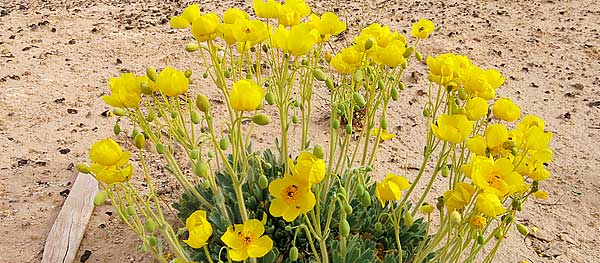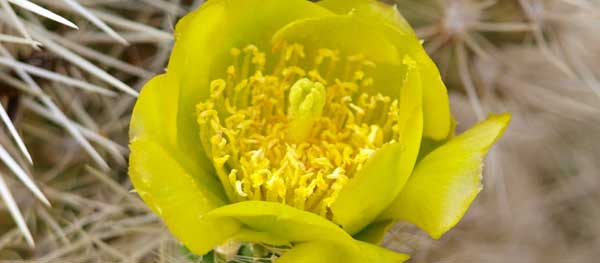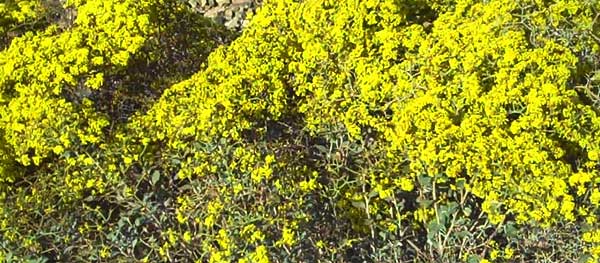The urban environment of Las Vegas today surrounds a unique diversity of plants and animals found at the Springs Preserve. However, after decades of agricultural and urban development, dozens of plants and animals in Southern Nevada are considered rare, driven to the brink of extinction by expansion, off-road-vehicle use and other recreational activities. One of the Springs Preserve's goals is to study and help these rare Mojave Desert species survive these obstacles.
The Springs Preserve was once home to several springs that combined to form the historic Las Vegas Creek, which supplied water to ancient Native Americans, early explorers, and pioneers. The water sustained lush and diverse vegetation consisting of grassy meadows and thickets of mesquites and willows that harbored a diverse array of wildlife.
By the early 1960s, the springs stopped flowing to the surface and much of the nearby vegetation died. The loss of water also led to the demise of the Las Vegas dace and the Vegas Valley leopard frog. In addition, human-caused disturbances including roads, utility corridors, dumping sites, and water distribution facilities also impacted the 180-acres we now call the Springs Preserve.
Habitat restoration efforts at the Preserve began in 2000 and have involved cleanup, importing topsoil, recontouring land surfaces, propagating and planting native plants, seeding and irrigating.
In addition, animal rewilding efforts have been underway since 2015, with the creation of a 15-acre habitat for federally threatened desert tortoises, including the charismatic and iconic Mojave Max.
Tortoises are "ecosystem engineers" that dig burrows, which are shared with all manner of invertebrates, mammals, reptiles and even some bird species during the heat of the summer. This means that the tortoises are also a keystone species, which are animals that have a large effect on the ecosystem and the other species they share it with.
To date, more than 90 acres have been restored, including:
- Three acres of wetland, including a stream and 6 habitat ponds.
- The restoration of portions of the historic Las Vegas Creek.
- The re-creation of several different native plant communities found throughout the Las Vegas Valley.
- The restoration of unique plant communities such as the community occupied by the rare Las Vegas bearpoppy.
In 2018, the federally endangered Pahrump poolfish and state-protected relict leopard frogs were released into refugium ponds at the Preserve, created in the north fork of the historic Las Vegas Creek. In addition, hundreds of tadpoles were moved from the refugium ponds to the Cienega in 2021 and 2022, leading to the establishment of another relict leopard frog population in the much larger Cienega by 2023.
Visitors to the Springs Preserve can access the north fork refugium ponds by taking the trails to Cottonwood Grove. But be patient, as these tiny residents can be hard to detect. Relict leopard frogs and Pahrump poolfish are most active from May to September and are well camouflaged within their surroundings.
A federally threatened species has found refuge and enjoys greater public awareness at our 15-acre desert tortoise habitat.
A frog and a fish. Not the most glamorous of animals, but to Nevada biologists, these animals are not one, but two lucky finds.
JENGA IN THE WILD 🎙 Dr. Ray Saumure, our Senior Environmental Biologist, talks with the Water Smarts Podcast about the challenges of repopulating endangered species and how the discovery that relict leopard frogs are cannibalistic may help ensure a sustainable population.
Publications
Springs Preserve staff and colleagues have published a number of groundbreaking discoveries:
Reports
In addition, the following reports summarize annual activities:
Pahrump poolfish
- 2023 Annual Summary of Activities – Pahrump poolfish Safe Harbor Agreement
- 2022 Annual Summary of Activities – Pahrump poolfish Safe Harbor Agreement
- 2021 Annual Summary of Activities – Pahrump poolfish Safe Harbor Agreement
- 2020 Annual Summary of Activities – Pahrump poolfish Safe Harbor Agreement
- 2019 Annual Summary of Activities – Pahrump poolfish Safe Harbor Agreement
- 2018 Annual Summary of Activities – Pahrump poolfish Safe Harbor Agreement
Relict leopard frogs
- 2024 Annual Summary of Activities – Relict leopard frogs at the Springs Preserve
- 2023 Annual Summary of Activities – Relict leopard frogs at the Springs Preserve
- 2022 Annual Summary of Activities – Relict leopard frogs at the Springs Preserve
- 2022 Translocation of relict leopard frog tadpoles from the existing refugia ponds to the Cienega at the Springs Preserve
- 2021 Translocation of relict leopard frogs from the existing refugia ponds to the Cienega wetland at the Springs Preserve
- 2018 Relict leopard frog (Lithobates onca) refugia at the Springs Preserve
Rare Plant Research

Las Vegas bearpoppy
The Las Vegas bearpoppy (Arctomecon californica), which grows only in the Las Vegas area, was discovered at the Springs Preserve in 1988 and has been listed as "critically endangered" by the State of Nevada. Federal, state and local agencies and entities are working together to ensure its protection and long-term conservation.
All bearpoppy populations at the Springs Preserve are fenced to protect the species and its habitat. It grows in two distinct areas within the Springs Preserve's boundaries. The Preserve has conducted several germination trials on the Las Vegas bearpoppy, which were initially successful but the plants failed to thrive. We will continue our efforts to unlock the mysteries of growing this fascinating and beautiful plant.

Blue Diamond cholla
The Blue Diamond cholla (Cylindropuntia multigeniculata) is a shrubby cactus with short spiny joints found primarily in the Blue Diamond Hills of the Spring Mountains in Clark County, Nevada. This small cactus grows up to two feet tall and is quite long lived.
The Federal Bureau of Land Management considers this plant to be a sensitive species. Specimens of the Blue Diamond cholla are on display in our Mojave Cactus Collection.

Las Vegas buckwheat
The Las Vegas buckwheat (Eriogonum corymbosum var. nilesii) can only be found in Clark and Lincoln Counties in Nevada at elevations between 656 and 2,789 feet. It is a mounding perennial shrub that can grow to four feet tall and wide with masses of fragrant yellow flowers from September to November.
The Federal Bureau of Land Management considers this plant to be a sensitive species. Several large specimens were salvaged and successfully transplanted to the propagation facility at the Springs Preserve. Seed collected from these plants have been grown, transplanted into the Botanical Garden and the two Las Vegas bearpoppy communities at the Springs Preserve, and sold at plant sales. Learn more about the Las Vegas Buckwheat.
